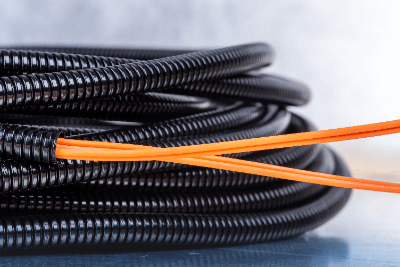What Is Corrugated Tubing?

Corrugated tubing is utilized to safeguard electric wires and organize wiring.
There are two types of corrugated tubes: one with slits for easy wire insertion and removal, and the other without slits to maintain airtightness.
Corrugated tubing, as the name suggests, has a corrugated shape, and its flexibility makes it an ideal wire protection material that can easily conform to wire routing. It is durable, resistant to collapsing under pressure, and suitable for both indoor and outdoor applications, depending on the material.
Typically, the color is primarily black, but for automotive applications, a noticeable orange color is used to easily identify the protection of high-voltage wires. Transparent white products are also available for medical applications.
Uses of Corrugated Tubing
Corrugated tubing is employed to shield electrical wires from wear and tear.
The insulation of an electric wire alone cannot withstand external factors such as mechanical stress or exposure to sunlight, potentially causing the wire’s conductor (core gland) to become exposed due to sheath damage. This could result in electrical leakage and even a fire hazard.
For instance, in outdoor applications, non-slit corrugated tubing is suitable for use in drainage systems. Its ease of processing, flexibility, and airtightness make it valuable for rain gutter applications on golf carts, vehicles, and as drainage piping for outdoor components of home air conditioning units.
The robust and flexible resin material provides protection against impact, abrasion, and heat. It finds application in a wide range of scenarios, used for wire protection and organization in factories, construction sites, automobiles, offices, PCs, and office automation equipment.
There are also various types of corrugated and alternative tubing designed with excellent flame and heat resistance for various applications. The tubing’s length can be easily adjusted using a cutter.
Characteristics of Corrugated Tubing
Corrugated tubing is available in two variants, with or without slits for wire entry.
1. Corrugated Tubing with Slits
Slit corrugated tubing offers the advantage of easy installation. Since it does not require pre-crimping of wire ends and can be installed after wires are in place, it reduces the overall processing time for wire end treatment.
However, it necessitates additional measures to prevent wire protrusion. In subsequent processes, PVC tape is often used to prevent cracks and to bundle or partially wrap the wires. Partial wrapping is costly and time-consuming, so it is advisable to consider designs that do not require slits.
For slitted tubing, while it is convenient for wire insertion, leaving wires exposed through the slits when bent or getting wires caught in the slits can lead to breakage. To prevent this, it is recommended to wrap corrugated tubing with slits in vinyl tape to keep the slits closed during wire installation.
2. Corrugated Tubing without Slits
Non-slit corrugated tubing eliminates the need for special measures to prevent wire protrusion. The steps required for slit-type tubing are no longer necessary, but securing the tube to the wires is still required by fastening it to a part of the wire.
The drawback is that attaching it to the wire can be challenging, and there are process limitations. Since wire threading must be done before crimping wire terminals, it impacts post-threading process efficiency.
In the case of non-slit tubing, the corrugated tubing must be threaded onto the wires before terminals are crimped. This reduces material costs and processing time. Additionally, the closed cross-section makes it less susceptible to dust and water penetration compared to slitted tubing.
Both slitted and non-slitted variants have their advantages and disadvantages and should be chosen based on specific applications and requirements. There are various inner diameters of tubing to consider based on the number of wires to be inserted.
Other Information on Corrugated Tubing
Corrugated Tubing Materials
The most common materials used for corrugated tubing are polypropylene, polyethylene, and nylon, each offering distinct price points and characteristics to suit various applications.
- Polypropylene: Heat resistance ranges from -50°C to 95°C. It is suitable for outdoor use due to excellent weather resistance. It is flame retardant and self-extinguishing.
- Polyethylene: Heat resistance is approximately -40°C to 50°C. It is used outdoors thanks to excellent weather resistance. Transparent white types are suitable for medical applications as they allow visibility inside.
- Nylon (Polyamide): Heat resistance ranges from -50°C to 125°C. Many products offer excellent heat resistance. It is flame retardant and self-extinguishing.
In some regions, rodents may enter equipment and chew on soft cables, leading to wire damage. Certain corrugated tubing includes a repellent that discourages rodents to prevent such damage.